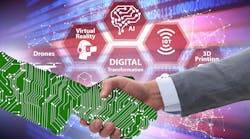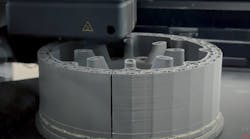By many accounts, 2020 was sure to be "the year" for digital transformation. Pilots were fruitful enough to convince manufacturers about the importance of data. Manufacturers heard the growing call for mass customization and streamlined operations. Investments were made. Strategic plans were set in place.
Then COVID-19 happened, and a new normal slowly started to surface.
Of course, navigating the new normal does not have to be a road block. As Colin Parris, the new CTO of GE Digital, tells IndustryWeek, a successful digital transformation is always about two things: leveraging a mix of technologies in order to better deal with evolving productivity requirements and changing business dynamics.
The new normal has just an added twist. “From the productivity notion, companies now need to do more with less, but from further away,” says Parris, who initially joined GE in 2014 after spending over a decade in leadership roles at IBM. Also, as digital has gained momentum within manufacturing, whether it’s about customization, resource management or getting cost out, COVID-19 now has “manufacturers dealing with highly variable changes to both the long- and short-term dynamics.”
Fortunately, digital has a great role to play in navigating the new normal, especially as manufacturers look to address a number of questions:
- How you collect the data to make those decisions?
- How do you make those decisions using analytics?
- What role can digital twins play?
- Do those decisions give you the ability to get enough early warning of things to come?
- How can you continuously predict failures or ways to take advantage of opportunities, and then actually optimize?
How exactly the pandemic is impacting organizations comes through loud and clear as Parris talks about a discussion he had about with the CEO of a big electric utility about digital transformation. “Last year his team said it would take five years, and billions of dollars to complete. Then COVID-19 came, and in five days they were operating remotely with skeleton crews of close to one third of their people,” he says. “We got them as right as we could. Rather than having everything 100% right, it ended up being 70-80%. But people learned to deal with that. It becomes a situation where this part is good with digital, but you've got to add insights and progressively get better. The ability to fail given the situation and continually go forward was profound.”
According to Parris, a lot of companies are continuing their digital investment, with a few “doubling down” on their strategies. “There are a couple of realities surfacing here: In addition to productivity, people are asking for real visibility not only into performance, but also the financial impact,” he says. “COVID-19 has emphasized the need to look at financials to understand base cost versus variable cost. Digital could enable leaders to make much more intelligent decisions. This is becoming more vital than ever.”Meaningful technologies in the COVID-19 Era
Obviously, digital encompasses a wide array of technologies, each with the potential to dynamically change how manufacturers operate. However, there are a few technology groups where Parris is seeing significant growth.
Touchless. Understandably, no company wants its operational processes to play a role in transmission of the virus. As such, there is a drive to enable environments where people can remain productive without touching the screens. “They want a way to walk up to equipment and either use gestures or enable personal mobile devices to use Bluetooth to take control after a machine detects an approved operator's badge,” he says.
Likewise, in older plants where it’s necessary to regularly take readings from meters and gauges, yet not worth re-instrumenting or putting sensors on an array of old equipment, cameras or drones could provide visualization – not just of readings, but what is going on in the environment. Of course, there is complex because numerous variables exist in these environments (i.e. dials may be curved or have grease on the face).
Collaboration. As companies suddenly embarked on work from home scenarios, the process helped collaboration technologies evolve well beyond the video conferencing calls commonly associated with remote work. “There are times in which I'm going to plant, I need to show you something in real-time. And, maybe I need to draw a circle around something to identify certain things that are critical,” he says. “These kinds of technologies are useful when it's necessary to virtually take an expert into an area where something is actually happening. It's about enabling people from around the world to have informed discussions. Visualization techniques add significant value.”
Humble AI. The whole purpose of a digital twin is to create a living model of an asset that enables companies to make decisions better and faster than a human. Of course, to be highly accurate, models need to be based on a lot of collected data. However, Humble AI can step in when deviations occur – something GE Digital has been actively piloting within the renewable energy space. “Data is plentiful on a wind farm, and as a result, we know normal wind is between 7-9 meters per second, which has allowed us to build an AI algorithm that works much better than any human could create. However, when wind starts to blow differently because of a stormy month and it gets to 10, you don't want that algorithm making decisions because the data it used focuses on its area of competencies between seven and nine,” he says. “In these scenarios, you want to go back to the original human-built algorithm. The AI algorithm needs to be humble enough to say the current situation is outside my competency, go back to the human algorithm and give me more data to improve.”
GE Digital is excited about bringing this technology into parts of the manufacturing space, explains Parris. And its customer, Cascades Tissue Group, is already pulling a lot of visualization information in, which is proving useful during the COVID-19 era. As part of its growth strategy, Cascades acquired several manufacturing sites, resulting in disparate automation infrastructures. Some of the plants were over 100 years old without a lot of data or deployed sensors, complicating monitoring capabilities. GE Digital helped Cascades embark on a phased approach to upgrade automation infrastructure of the paper line across its key manufacturing sites. With a single view of production data, operators can make informed decisions that help drive quality improvements and increase manufacturing efficiency.
“They needed look at their plants in a broad way. Visualization allows them to do a lot more work, understand what's going on and figure out how to drive better yield,” he says. “That's the perfect place to go in and see how else to use all of this data. You have enough to run a couple of digital twin experiments with Humble AI to try to do some things within zones of competencies that makes sense.”
The elephant in the room
Understandably, transformation does not simply occur. And, the biggest obstacle in ramping up digital efforts in today’s, at best, uncertain market is money. “COVID-19 obvious has a truly catastrophic human impact, and unfortunately the economic impact is going to be enormous as well," says Parris. "As global buying behaviors slow down, the ripple effect is going to hit manufacturing because consumption is going to go down. When people lack jobs and have a sense of uncertainty about the future, they buy less. As this develops, people are going to question if they have the money to do the things they want to do.”
There is a path to success: combining digital with lean. At GE, Larry Culp brought with him a cadre of really good lean experts. “Lean really is all about business transformation. And the brilliance about that is if you combine lean with digital, there is a beautiful synergy. With lean, you go through a value stream map to looking at the flow from raw materials to the end products, removing waste along the way. At the end, you deliver the product to the customer at the right time, with minimal waste leveraging the right productivity and costs.”
In order to make lean work, organizations need to collect a ton of data against KPIs to actually understand where things are getting better, analyze what's causing issues and constantly monitor to know if when operations are dropping below standard work expectations. "Lean forces you to bring the data out, and it forces you to constantly have the data so that you know if you're operating at the threshold you desire," he says. "It also forces you to do continuous improvement. You can then bring in digital data collection capabilities, digital twins, digital analytics, and use these tools to determine the most optimal thing to do. There's nobody in individual silos (manufacturing, engineering, finance, etc.) making decisions that affect further downstream without them knowing.”
Bottom line? “Taking out waste gives you the money you need to invest in the digital technology and continuously improve,” says Parris. “The lean/digital combination is what manufactures need going forward – taking the money viewed as waste and using it on products with purpose.”
Eye on the prize
Drawing from his experiences at IBM and GE, Parris has a few primary goals as CTO. His first goal is to capitalize on the work taking place within GE's Global Research Center and its partnerships to enhance current products as well as develop new products. “The research allows you to understand differentiators and productize them. Once you productize them, you try to understand how to monetize them at the same way and ultimately adapt,” he says. “Secondly, I am focused on taking the lean-digital combination and to transform GE’s businesses.”
Of course, at least initially, the biggest challenge is cultural. And the current environment understandably complicates facilitating change. “In this type of environment, people’s natural reaction is to hunker down, and try to go back to what they knew before. However, what people did before won't work now simply because of the situation we are in,” he says. “Survival is not going to be an isolated act, it has to be a systems act, we have to collectively survive. You need to actually join in order to make it happen.”
Creativity is going to play a pivotal role in overcoming the obstacles, explains Parris. “Usually people say let's shut down creativity because it's risky. However, taking the right risks will allow you to emerge from this so much stronger,” he says. “I need to get people to come out of the mode of protect, conserve and go away from risk in favor of some measured risk.”
Strategically looking at the ecosystem is also crucial. “You need to pick the right partnerships and work together. If you look at the aviation industry, it's not going to be the engine manufacturers or the frame manufacturers. It’s also the airlines and governments. It has to happen collectively. With every country shutting down borders in certain ways, and the control of goods in-goods out, people are getting protective about what's built here, and where the jobs coming in. It’s time to think about each of these micro ecosystems and how they impact the supply chain.”
Building the right culture
Like any leader, Parris has learned a lot of hard lessons. Hard lessons that have provide him with valuable insights as he works to build the right culture. “If you get awareness, learning and resiliency right, it is the hallmark of leadership,” he says.
Awareness. “If you're not aware of when something is changing with customers, competition or trends, you can end up sitting in a bubble,” he says. “I spent a lot of time with my team, fostering awareness, looking at different things outside of our realm, looking at other trends and trying to understand how they impact us. As much as we may think we're immune, we are a system of systems.”
Learning. “The nature of the world is changing at such a rapid rate, and the more people interconnect, the more the synergistic element grows. Learning also means improving your network of others learning,” he says. “You need to be humble enough to acknowledge while you only know 5% on something, chances are you have someone in your learning network who can help.”
Resiliency. “You are going to fail, you are going to fall down and you are going to get back up,” he says. “You can't look at failures as anything but the process by which you learn. If you have the awareness of other people's field, if you've seen other people constantly learning and still failing, your resiliency builds as well.”





